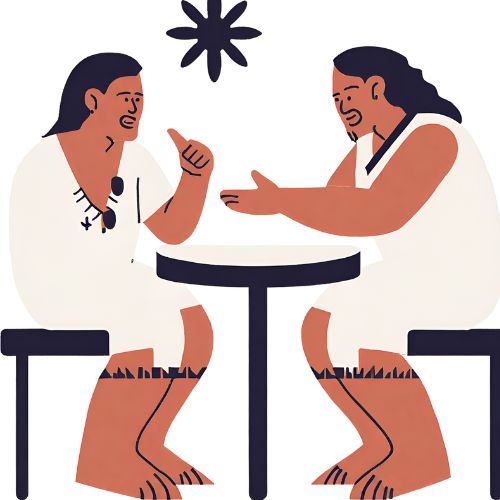Pronouncing T,K,N,G
Caption:
Another big question in Samoan pronunciation and inflection is T vs K. Is T formal and K informal?
For my whole life that’s the way I knew it. My first video that’s how I explained it. People were in the comments saying that’s right, that’s wrong. So I never talked about it again.
But I’m gonna speak my truth, Some Samoan people act like it’s one way all across the diaspora. Samoans are all over the world. For me, T style has always been formal, and K style was informal and casual.
Someone did point out that if an elder was using a stern tone, even in a formal ceremony, they might shift gears to K style to let you know, they’re playing with you.
But us regular folks. T words can be pronounced with K
Tama , Kama
ta’avale, ka’avale
tupe, kupe
tina, kina
Sometimes I’m making videos and by the end of the video I’m more comfortable and accidentally slip and say words in K style. And that’s why I do that, I get comfortable and switch gears and pronounce my T words with a K
Now, words that begin with K are only with K.
Kalapu or Club is not Talapu
Koko alaisa is not Toto Alaisa,
No one is gonna eat Toto alaisa
One thing everyone seems to agree on is if you’re speaking in T- style, don’t be switching gears back and forth to K-style in the same conversation, especially not in the same sentence.
Me personally I don’t think of T-style and K-style as just difference pronunciation. It’s like switching gears from using my work voice, and once I see you’re cool now I’m speaking in AAVE . How would I sound if I’m going back and forth from work voice to cool voice in the same sentence. You would think I was shocking.
This principle is the same with words with the letter n and g.
N is pronounced n
G’s are g like ng like sing
N’s are like the T’s
they can be pronounced with with n or g
For example, manino means clear
Mafananana means warm
We said these in N style
Because N’s can be said with G’s, you’ll hear people say “magigo” or “mafagafaga’ once they switch gears.
But it don’t work the other way around. Words with g are only pronounced with G
galo is to forget, it’s not nalo
galuega is job, it’s not naluena
Samoan consonants
Tofa Soifua or Kofa Soifua
For more lessons visit Youtube, Instagram, Tiktok, Totolua
Understanding Fa’ataofi (Glottal Stops) and Fa’amamafa (Macrons) in the Samoan Language
The Samoan language, or Gagana Sāmoa, is a rich and expressive Polynesian language spoken primarily in the Samoan Islands. Like many other languages, it has unique phonetic and orthographic features that are essential for proper pronunciation and meaning. Two such critical elements are the fa’ataofi (glottal stop) and the fa’amamafa (macron). Understanding these elements is vital for both learners and native speakers to maintain the integrity of the language.
Fa’ataofi (Glottal Stops)
Definition and Importance
A fa’ataofi, or glottal stop, is a phonetic sound produced by obstructing airflow in the vocal tract. In written Samoan, it is represented by an apostrophe (‘). The glottal stop is a significant consonant in Samoan, distinguishing words that would otherwise be identical. Its presence or absence can change the meaning of a word entirely, making it crucial for clarity and accuracy in communication.
Examples and Usage
Consider the following examples to understand the impact of the glottal stop:
- ’a (jaw) vs. a (but)
- ’upu (word) vs. upu (laws)
- fua (fruit) vs. fu’a (flag)
In these examples, the presence of the fa’ataofi in words like ’a, ’upu, and fu’a changes their meanings significantly from their counterparts a, upu, and fua. Mispronouncing or omitting the glottal stop can lead to misunderstandings, as it alters the intended message.
Phonetic Characteristics
Phonetically, the glottal stop occurs when the vocal cords are brought together to stop airflow and then released, creating a brief, sharp sound. It is common in many languages, including English, where it occurs in words like “uh-oh” and “button” (in some dialects). In Samoan, it is phonemic, meaning it serves as a fundamental unit of sound that distinguishes meaning between words.
Fa’amamafa (Macrons)
Definition and Importance
A fa’amamafa, or macron, is a diacritical mark placed over a vowel to indicate a long vowel sound. In Samoan, vowels can be either short or long, and the length of the vowel affects the meaning of words. The macron is represented by a horizontal line (¯) placed above the vowel. Long vowels are pronounced with greater duration than short vowels, and this distinction is phonemic.
Examples and Usage
Consider these examples to understand the role of the macron:
- fā (to build) vs. fa (four)
- mālō (government) vs. malo (hello)
- sā (forbidden) vs. sa (group)
In each pair, the word with the macron has a different meaning from the word without it. Proper use of the fa’amamafa is essential for accurate communication and to avoid confusion. Misplacing or neglecting the macron can lead to misinterpretation of the speaker’s or writer’s intent.
Phonetic Characteristics
Phonetically, long vowels are held for a longer duration than short vowels. The length of the vowel sound can affect the rhythm and flow of speech. For example, in singing or formal speech, the distinction between long and short vowels can be particularly pronounced, adding to the musicality and expressiveness of the language.
Integrating Fa’ataofi and Fa’amamafa in Learning
For learners of Samoan, mastering the use of fa’ataofi and fa’amamafa is critical. Here are some strategies to help:
- Practice Pronunciation: Regularly practicing with native speakers or using language learning apps can help internalize the correct pronunciation of glottal stops and long vowels.
- Reading and Listening: Exposure to written and spoken Samoan, including books, songs, and conversations, reinforces the correct use of these phonetic features.
- Writing Exercises: Writing practice, with a focus on proper use of the apostrophe for glottal stops and the macron for long vowels, helps solidify understanding.
Cultural Significance
The proper use of fa’ataofi and fa’amamafa goes beyond phonetics; it is a matter of cultural respect and preservation. The Samoan language is an integral part of Samoan identity and heritage. Accurate pronunciation and writing maintain the language’s beauty and integrity, ensuring that it is passed down correctly to future generations.
Conclusion
The fa’ataofi (glottal stop) and fa’amamafa (macron) are essential components of the Samoan language. They play a crucial role in distinguishing word meanings and maintaining the phonetic and rhythmic integrity of speech. For learners and native speakers alike, mastering these elements is vital for clear, accurate communication and for preserving the rich linguistic heritage of Samoa. By paying attention to these details, we honor and uphold the beauty and precision of Gagana Sāmoa.





